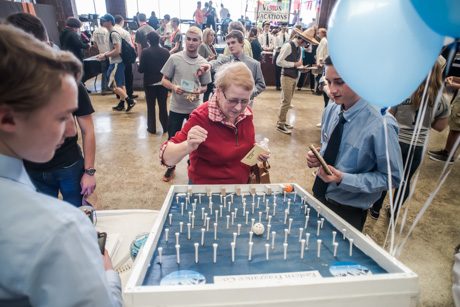City fire officials: Change your clocks on Sunday and your smoke alarm and CO detector batteries, too
Press release:
The City of Batavia Fire Department is joining nearly 6,000 fire departments nationwide in promoting the annual "Change Your Clocks, Change Your Batteries" campaign on Sunday, March 13.
Fire Prevention Officer Lt. Jeff Whitcombe encourages all residents to adopt the simple, life-saving habit of changing smoke alarm and CO detector batteries when they change their clocks back from daylight savings time to standard time.
“It’s an easy, inexpensive and proven way to protect your family and your home,” Lt. Whitcombe said.
Since 1987, the International Association of Fire Chiefs has joined forces with Energizer batteries to spread the message that non-working smoke alarms are responsible for needless death and injuries. Now 25 years later, thanks to the Change Your Clocks, Change Your Batteries campaign, home fire deaths continue to decline.
Recent surveys conducted for the National Fire Protection Association (NFPA) and the Consumer Products Safety Commission found that 96 percent of all home have at least one smoke alarm, but only 75 percent have at least one working smoke alarm. Almost two-thirds of home fire deaths resulted from fires in homes with no smoke alarms or no working smoke alarms. Smoke alarm failures usually result from missing or dead batteries or disconnected wires.
The peak time for home fire fatalities is between 11 p.m. and 7 a.m. when most families are sleeping. A working smoke alarm can provide the critical extra seconds needed to get people out safely.
According to the NFPA, the maximum life cycle of a smoke alarm is 10 years from the date of manufacture, not the date of installation. Beginning in 2002, all smoke detectors must have a manufacture date marked on the outside of the smoke alarm. If your smoke alarm does not have a manufacture date, then it is older than 10 years and must be replaced. The City of Batavia Fire Department recommends purchasing smoke alarms with 10-year lithium batteries. All smoke alarms should be tested monthly.
Families should also practice "Exit Drills in the Home" (E.D.I.T.H.) and have a meeting place outside the home to quickly account for all the occupants during an emergency. The meeting place should be something that is not mobile like a tree or mailbox by the street.
A carbon monoxide detector or CO detector is a device that detects the presence of the carbon monoxide (CO) gas in order to prevent carbon monoxide poisoning. CO is a colorless and odorless compound produced by incomplete combustion. It is often referred to as the “silent killer” because it is virtually undetectable without using detection technology. Elevated levels of CO can be dangerous to humans depending on the amount present and length of exposure. Smaller concentrations can be harmful over longer periods of time while increasing concentrations require diminishing exposure times to be harmful.
CO detectors are designed to measure CO levels over time and sound an alarm before dangerous levels of CO accumulate in an environment, giving people adequate warning to safely ventilate the area or evacuate. All CO detectors should also be tested monthly. Remember, if your CO detector alarms, you should evacuate the structure and dial 9-1-1. The fire department will respond and investigate the cause of the alarm.
The City of Batavia Fire Department has a free smoke alarm and battery installation program.
According to Lt. Whitcombe, “We have installed hundreds of smoke alarms and batteries over the past 20 years and will continue to do so until everyone who needs them has them.”
For information about the free smoke alarm and battery installation program, City of Batavia residents should contact the City of Batavia Fire Department at (585) 345-6375.







































